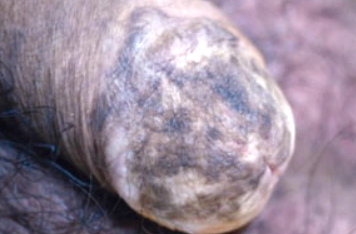Atypical penile macules are a rare condition characterized by large and merging irregularly shaped pigmented spots on the shaft and glans of the penis. The ICD-10 code for this condition is L81.4.
The disease typically manifests in adolescence and adulthood. Etiology and pathogenesis are not well understood. Clinically, atypical melanotic macules resemble melanoma, requiring careful observation of the patient. There is ongoing debate regarding the terminology, with some authors considering this condition as focal genital melanosis, while others classify it as a separate nosological entity.This condition is characterized by the appearance of large, irregularly shaped, pigmented patches on the shaft, glans, and foreskin of the penis that are fused together. The spots may vary in color, including brown, black, and dark blue. Areas of hypopigmentation and unaffected skin contribute to the distinctive mottled (reticular, mesh-like) clinical presentation of the affected area.
The disease typically progresses without symptoms.
Diagnosis is based on clinical presentation. Because the condition often mimics malignant melanoma, a histological examination is recommended, which reveals hyperpigmentation of the basal layer without melanocytic atypia or proliferation.
- Melanoma in situ
- Melanoma
- Lentigo
- Café-au-lait macules
- Penile melanosis
- Melanocytic nevus
- Laugier-Hunziker syndrome
- Bannayan-Riley-Ruvalcaba syndrome
Treatment involves excision of the affected areas followed by histological examination. Extensive lesions may require photographic monitoring.

